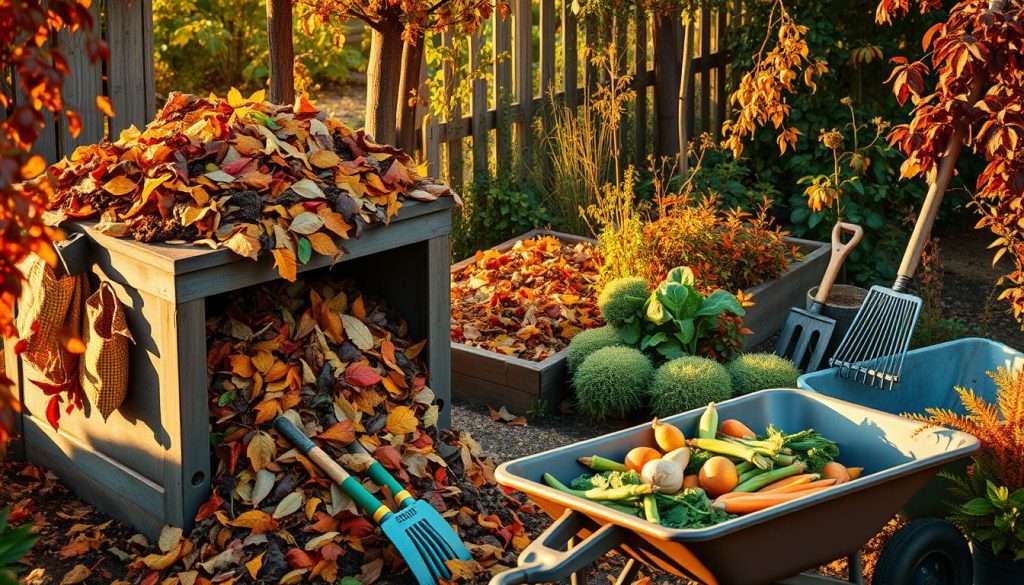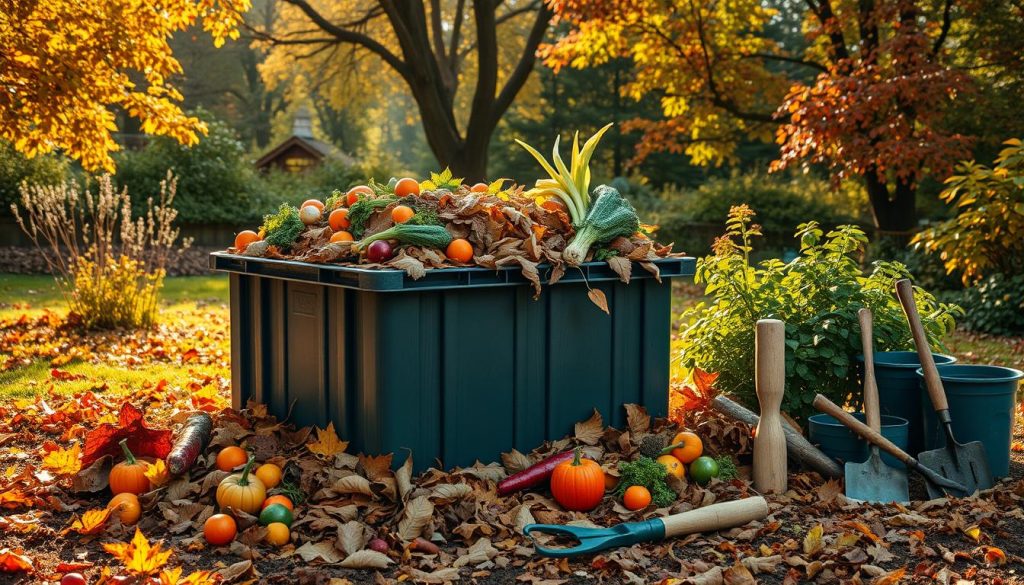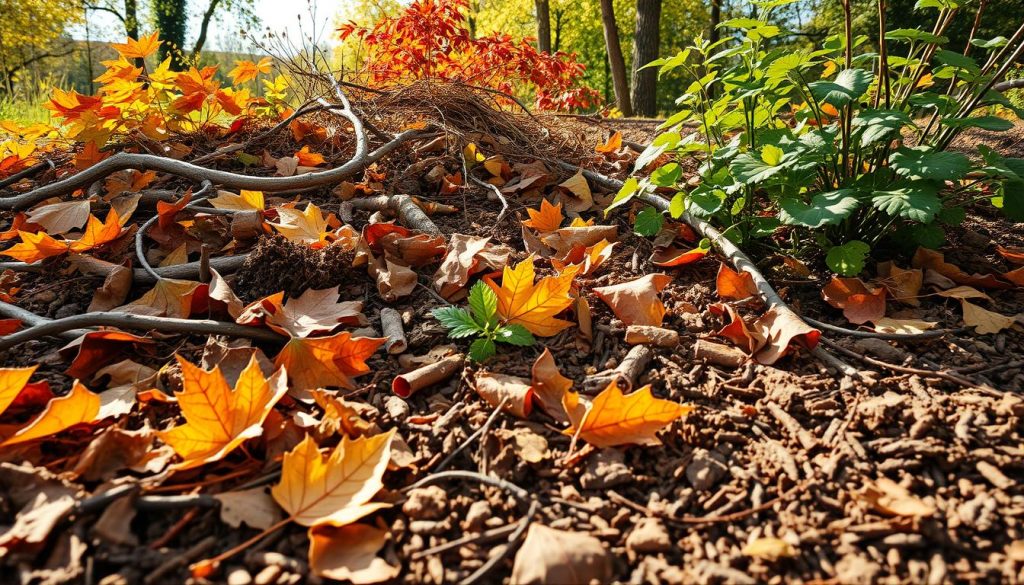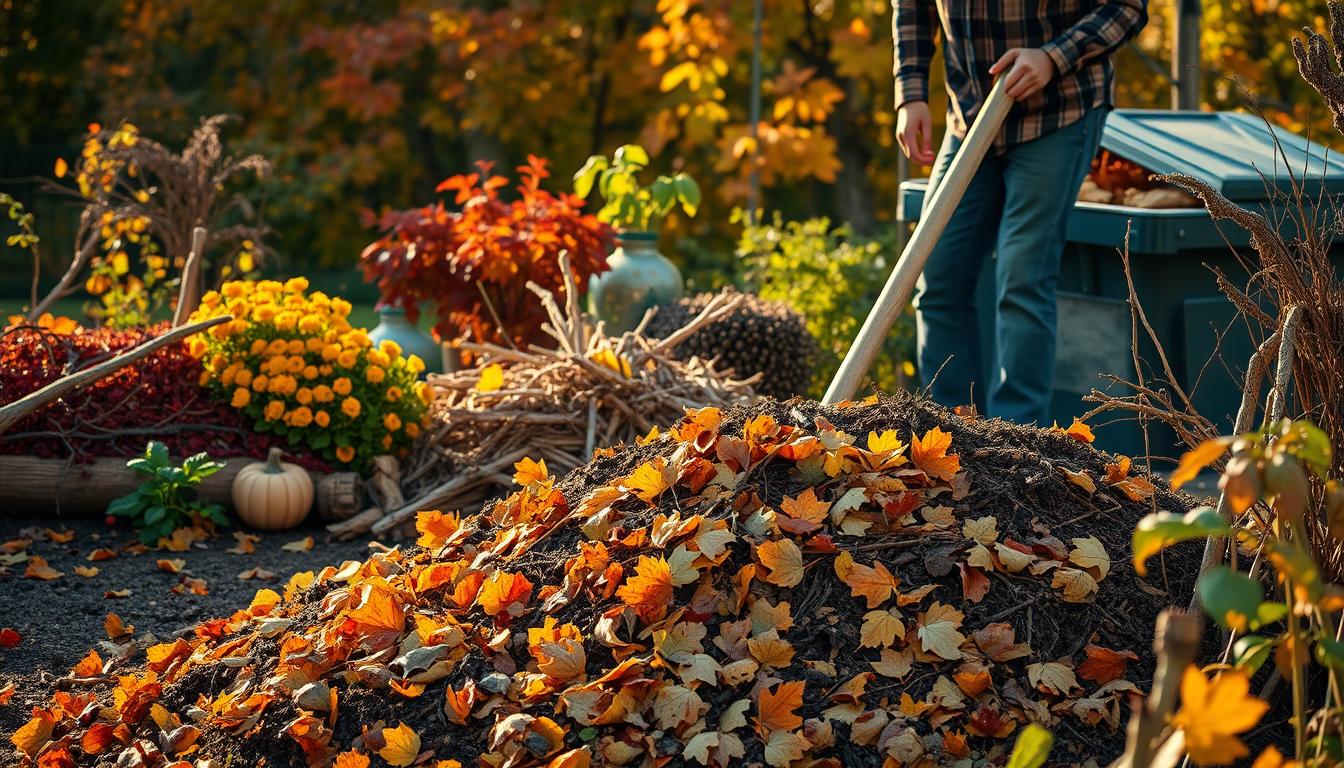As fall comes, I’m excited to clean up my garden. I want to do it without wasting anything. I’ve found that old ways of cleaning gardens can lead to a lot of waste. So, I’m using eco-friendly tips to keep my yard green.
I’m all about keeping my garden clean and green. I’m using compost and mulch to cut down on waste.
I’ll share how I clean up my garden in a way that’s good for the planet. It’s all about using eco-friendly tips and keeping our gardens sustainable. With a few easy steps, we can all make our gardens better for the environment.
Understanding the Importance of Fall Garden Cleanup
Starting my fall garden cleanup, I see how crucial it is for a healthy outdoor space. Using organic methods to dispose of garden waste helps reduce landfill waste and my environmental impact. These practices are good for the planet and my garden’s health.
Some key benefits of fall garden cleanup include:
- Reduced waste: Composting and mulching cut down on waste during cleanup.
- Improved soil health: Composting makes the soil richer, helping plants grow better.
- Enhanced aesthetic appeal: A clean garden looks better and adds value to my property.
Adding green garden practices to my cleanup routine makes my outdoor space more sustainable. It’s better for the environment and keeps my garden healthy for years.
Assessing My Garden’s Needs
To start a zero-waste autumn gardening plan, I first assess my garden’s needs. I look closely at my yard’s current state, including plants, debris, and layout. This helps me spot areas needing attention and plan for eco-friendly yard care and natural waste management.
Walking through my garden, I note which plants are doing well and which are not. I think about the types of plants I have, their growth, and needs. This helps me figure out which plants can be composted, reused, or recycled, and which need proper disposal.
Inventory of Plants and Debris
I make a list of my garden’s plants and debris, including:
- Dead or dying plants that need to be removed
- Leaves and branches that can be composted
- Garden waste that can be reused or recycled
Identifying Healthy Versus Unhealthy Plants
I examine each plant carefully for signs of disease, pests, or damage. I look at:
- Plant health and vigor
- Presence of pests or diseases
- Damage from weather or other environmental factors

By assessing my garden’s needs and identifying areas for improvement, I can make a plan to reduce waste and promote sustainability. This zero-waste approach to autumn gardening benefits the environment and helps me maintain a beautiful, thriving garden with minimal care.
Composting: A Sustainable Solution
As I clean up my garden in the fall, I’ve learned how key composting is. It helps cut down on waste and makes the soil better. By composting, I can make my garden healthier and reduce harm to the environment.
To start composting, I need a good system. This means having a spot for composting and mixing different materials. This way, I can avoid using harmful chemicals and make my garden better.
Creating a Composting System
Choosing the right materials for composting is important. Here are some examples:
- Fruit and vegetable scraps
- Tea bags and coffee grounds
- Leaves and grass clippings
- Eggshells and bread scraps
Using these materials helps make a soil amendment that’s good for plants.

Tips for Successful Composting
To compost well, I need to balance my materials and keep the pile moist. I also need to turn it often. These steps help me reduce waste and make my garden better for the planet.
Mulching: A Waste-Free Approach
Mulching is a simple way to reduce waste and keep your garden healthy. By using organic materials like leaves or wood chips, you can keep the soil moist. This also helps control weeds and keeps the soil at the right temperature.
Mulching cuts down on the need for harmful chemicals. It’s great for those who want to care for their garden in a green way. Plus, it makes the soil better by adding organic stuff and helping good bugs grow.
Benefits of Mulching
- Retains moisture and reduces the need for frequent watering
- Suppresses weeds, reducing the need for herbicides
- Regulates soil temperature, promoting healthy plant growth
Types of Mulch I Use
I like to use natural stuff like leaves, straw, and wood chips. They’re easy to find and work well. These materials help your garden stay healthy and green.

How to Mulch Efficiently
To make mulching work best, use the right amount and type for your garden. Follow some easy tips and add eco-friendly gardening to your routine. This way, you’ll have a garden that’s good for you and the planet.
Reusing Garden Materials
As I clean up my fall garden, I’m excited to share my favorite ways to reuse garden materials. This approach is good for the planet and adds a personal touch to my garden. By reusing and upcycling, I create unique planters, decorations, and pathways. It’s all about zero-waste autumn gardening.
Some of my favorite ideas for reusing garden materials include:
- Transforming old pallets into planters for herbs or succulents
- Using fallen leaves as mulch or compost to enrich the soil
- Upcycling old garden furniture into one-of-a-kind decorations
- Repurposing old tools as plant markers or garden stakes
Being creative with reuse and upcycling helps me reduce my environmental footprint. It also adds character to my garden. This encourages me to think outside the box and find new ways to manage yard waste.
Exploring reuse in my garden reminds me of the importance of a zero-waste mindset, especially in autumn. It’s not just about reducing waste. It’s about creating a sustainable and beautiful garden that shows my commitment to eco-conscious yard care and natural yard waste management.
Recycling Plants and Green Waste
As I keep up with my eco-friendly yard cleanup, I focus on recycling plants and green waste. This is key to reducing waste and making my garden more sustainable. By using green garden practices, I make sure my waste is handled in an eco-friendly way.
I first look into local recycling options. I check with my waste management company to see if they handle organic garden waste. I also search for community composting programs to recycle my green waste.
Preparing Green Waste for Recycling
To get my green waste ready for recycling, I separate it from other waste. I also remove any debris or contaminants that could mess up the recycling. This means taking out plastic bags, twine, and other non-organic stuff.
Benefits of Recycling Green Waste
Recycling green waste has many benefits. It cuts down on waste going to landfills and makes compost that’s good for my garden. By doing environmentally-friendly yard cleanup, I lower my carbon footprint and make my garden more sustainable.
- Reduces waste sent to landfills
- Creates nutrient-rich compost
- Promotes sustainable gardening practices
By following these steps and using green garden practices, I recycle my garden waste in an eco-friendly way. This helps my garden and the environment too.
Planning for Next Season with Minimal Waste
As fall ends, it’s time to plan for next year’s garden. I’ll focus on reducing waste by choosing sustainable plants and setting up a waste reduction plan. This way, I can make my fall garden cleanup eco-friendly and sustainable.
Choosing Sustainable Plants
I’ll pick plants that need less care and water. These plants will help me create a sustainable garden. This choice will make my yard maintenance easier and greener.
Setting Up a Waste Reduction Plan
I’ll improve my composting and find new ways to use garden materials. A good waste reduction plan will help me reduce landfill waste. It will also help me find creative uses for leftover items.
Tips for Year-Round Waste Management
Keeping up with sustainable practices all year is crucial. I’ll keep composting, mulching, and recycling. I’ll also look for ways to reduce waste, like joining local green waste programs.
section>

